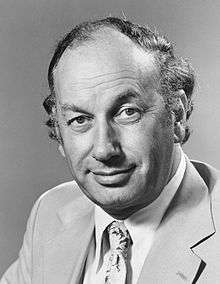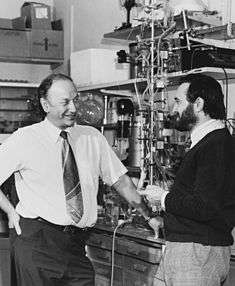John Vane
Sir John Robert Vane FRS (29 March 1927 – 19 November 2004)[1] was a British pharmacologist who was instrumental in the understanding of how aspirin produces pain-relief and anti-inflammatory effects and his work led to new treatments for heart and blood vessel disease and introduction of ACE inhibitors. He was awarded the Nobel Prize in Physiology or Medicine in 1982 along with Sune Bergström and Bengt Samuelsson for "their discoveries concerning prostaglandins and related biologically active substances".[2]
Sir John Vane | |
|---|---|
 | |
| Born | John Robert Vane 29 March 1927 |
| Died | 19 November 2004 (aged 77) |
| Nationality | English |
| Citizenship | British |
| Alma mater |
|
| Known for | |
| Spouse(s) | Elizabeth Daphne Page ( m. 1948) |
| Awards |
|
| Scientific career | |
| Fields | Pharmacology |
| Institutions | |
| Thesis | Blood flow and its relation to secretion in the stomach and smaller intestine (1952) |
| Doctoral advisor | Geoffrey S. Dawes |
Education and early life
Born in Tardebigge, Worcestershire, John Vane was one of three children and grew up in suburban Birmingham. His father, Maurice Vane, was the son of Jewish Russian immigrants[3] and his mother, Frances Vane, came from a Worcestershire farming family.[2] He attended a local state school from age 5, before moving on to King Edward's School in Edgbaston, Birmingham. An early interest in chemistry was to prove the inspiration for studying the subject at the University of Birmingham in 1944.
During his undergraduate studies, Vane became disenchanted with chemistry but still enjoyed experimentation. When Maurice Stacey, the Professor of Chemistry at Birmingham, was asked by Harold Burn to recommend a student to go to Oxford and study pharmacology, Vane jumped at the chance and moved to Burn's department in 1946. Under Burn's guidance, Vane found motivation and enthusiasm for pharmacology, writing: "[the] laboratory gradually became the most active and important centre for pharmacological research in the U.K. and the main school for training of young pharmacologists."[2] Vane completed a Bachelor of Science degree in pharmacology and briefly went to work at the University of Sheffield, before coming back to Oxford to complete his Doctor of Philosophy degree in 1953[4] supervised by Geoffrey Dawes.[5]
Career and research
After completing his DPhil, Vane worked as an assistant professor the Department of Pharmacology at Yale University before moving back to the United Kingdom to take up a post as a senior lecturer in the Institute of Basic Medical Sciences at the University of London in 1955.[6][7]
University of London

Vane held a post at the University of London for 18 years, progressing from senior lecturer to Professor of Experimental Pharmacology in 1966 (at the Royal College of Surgeons). During that time he developed certain bioassay techniques and focussed his research on both angiotensin-converting enzyme and the actions of aspirin, eventually leading to the publication with Priscilla Piper of the relationship between aspirin and the prostaglandins that earned him the Nobel Prize in Physiology or Medicine in 1982.[8][9][10][11]
Wellcome Foundation
In 1973, Vane left his academic post at the Royal College of Surgeons and took up the position as Director of Research at the Wellcome Foundation, taking a number of his colleagues with him who went on to form the Prostaglandin Research department. Under the leadership of Salvador Moncada, this group continued important research that eventually led to the discovery of prostacyclin.[6]
Return to academia
In 1985, Vane returned to academic life and founded[12] the William Harvey Research Institute at the Medical College of St Bartholomew's Hospital (now Barts and The London School of Medicine and Dentistry an institution of Queen Mary University of London).[13] At the William Harvey Research Institute, Vane's work focused on selective inhibitors of COX-2, and the interplay between nitric oxide and endothelin in the regulation of vascular function.[6]
Awards and honours
Vane was elected a Fellow of the Royal Society (FRS) in 1974.[1] He was also awarded honorary doctorate degrees from Jagiellonian University Medical College (formerly Copernicus Academy of Medicine) in 1977, Paris Descartes University in 1978, Mount Sinai School of Medicine in 1980 and the University of Aberdeen in 1983.[2] He was awarded the Lasker Award in 1977 for the discovery of prostacyclin and was knighted in 1984 for his contributions to science. In 2000, Vane received the Golden Plate Award of the American Academy of Achievement.[14]
Personal life
John Vane married in 1948 to Elizabeth Daphne Page and had 2 daughters. He died on 19 November 2004 in Princess Royal University Hospital, Kent, from long-term complications arising from leg and hip fractures he sustained in May of that year.[15]
References
- Moncada, S. (2006). "Sir John Robert Vane. 29 March 1927 -- 19 November 2004: Elected FRS 1974". Biographical Memoirs of Fellows of the Royal Society. 52: 401–411. doi:10.1098/rsbm.2006.0027. PMID 18551797.
- "John R. Vane – Autobiography". Nobelprize.org.
- According to an interview published in Candid Science II, by István Hargittai (Imperial College Press, London, 2002, p. 562).
- Vane, John Robert (1952). Blood flow and its relation to secretion in the stomach and smaller intestine (DPhil thesis). University of Oxford.
- Liggins, G. (1998). "Geoffrey Sharman Dawes, C. B. E. 21 January 1918-6 May 1996". Biographical Memoirs of Fellows of the Royal Society. 44: 111–125. doi:10.1098/rsbm.1998.0008.
- "Sir John R. Vane FRS, Nobel Laureate (1927–2004)". William Harvey Research Foundation.
- List of publications from Microsoft Academic
- Moncada; Ferreira, SH; Vane, JR (1975). "Inhibition of prostaglandin biosynthesis as the mechanism of analgesia of aspirin-like drugs in the dog knee joint". European Journal of Pharmacology. 31 (2): 250–60. doi:10.1016/0014-2999(75)90047-3. PMID 1149792.
- Ferreira; Moncada, S; Vane, JR (1973). "Further experiments to establish that the analgesic action of aspirin-like drugs depends on the inhibition of prostaglandin biosynthesis". British Journal of Pharmacology. 47 (3): 629P–630P. doi:10.1111/j.1476-5381.1973.tb08193.x. PMC 1776306. PMID 4199867.
- Ferreira; Moncada, S; Vane, JR (1971). "Indomethacin and aspirin abolish prostaglandin release from the spleen". Nature New Biology. 231 (25): 237–9. doi:10.1038/newbio231237a0. PMID 5284362.
- Vane (1971). "Inhibition of prostaglandin synthesis as a mechanism of action for aspirin-like drugs". Nature New Biology. 231 (25): 232–5. doi:10.1038/newbio231232a0. PMID 5284360.
- "William Harvey Research Institute". Queen Mary, University of London, UK. Retrieved 7 January 2012.
- "Queen Mary, University of London Notable Alumni and Staff". Archived from the original on 12 December 2007. Retrieved 23 September 2007.
- "Golden Plate Awardees of the American Academy of Achievement". www.achievement.org. American Academy of Achievement.
- Obituary:Sir John Vane. guardian.co.uk. 25 November 2004.
| Wikimedia Commons has media related to John Vane. |
